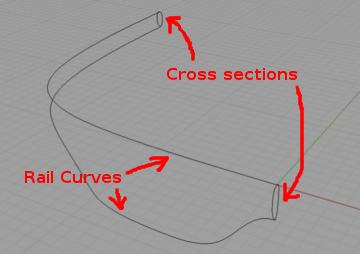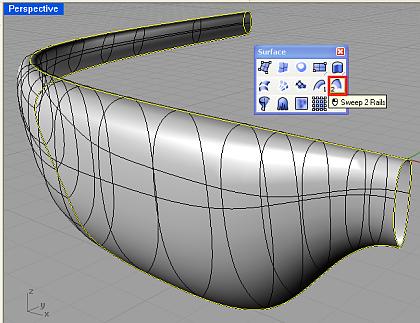Sweep 2 Rail
-
Hello, I was wondering how many of Rhino3D tools are possible to emulate with Sketchup plugins... (obviously, Im not asking to result in nurbs models)
This one is a very interesting case... Sweep Two Rails


The loft tool would also be good, but I think the one that someone tried to create didnt worked flawlessly as the ones in Rhino, right?
Also, I am not sure if there is already a plugin to do what I want, or even if there is a possibility of doing what I want without the need for a plugin.
I have an ARCH... just a bezier curve. At the base of the arch, I built a face, a triangle, with 1 side smaller than the other 2 sides. I want to make the arch an solid by using the Follow Me tool. Problem is, the triangle doesnt follows the bezier curve as I want it to. It doesnt rotates right (along the normals), and thus, on the other side of the arch, the side facing the inside of the arch is NOT the largest side of the triangle anymore!
-
Hello,
I can't see the images you posted. Please attach them to your post so they stay here, using "Upload attachment".
I think I can help you with the arch problem. Please post your .skp file so I can find a workaround.However, the features you need are already in MoI, and AFAIK, MoI can export to SketchUp almost flawlessly.
-
@ecuadorian said:
Hello,
I can't see the images you posted. Please attach them to your post so they stay here, using "Upload attachment".
done
@unknownuser said:
I think I can help you with the arch problem. Please post your .skp file so I can find a workaround.
I solved it, by rotating the surface to exactly face the other side of the arch... but what if I want a higher degree of control about how the surface rotates or change in size along the rail?
@unknownuser said:
However, the features you need are already in MoI, and AFAIK, MoI can export to SketchUp almost flawlessly.
sorry, what is MoI?
edit: checked on Google... its a NURBS editor that custs U$200... well, Rhino3D custs U$950, true.... but then, its also MUCH better than MoI and you also can render from VRAY or Maxweel directly from it.
Anyway... I would like to do these things INSIDE Sketchup, not using a 3rd party Nurbs modelling application.
-
It would be really cool if sketchup can do sweep 2.
I think it's the most powerful modeling tool in rhino. -
@unknownuser said:
... Rhino...its also MUCH better than MoI
Yes for number of functions

No for ergonomic
More and more people use it as pre-modeler to Rhino (when they have Rhino)
It's a stand alone prog! (can export directly to SU
So you can have your Sweep 2 rails (and many more) for less price than Rhino
And I don't see why you can't with Moi don't render In Vray or other as it's export in OBJ too
-
This is Sweep 2 Rails... you use TWO CURVES as rail lines and ONE CURVE as cross section.

this is actually the 3D Max Sweep 2 Rails... but it may give an idea... check the link, it shows some of the options used, descriptions, etc
http://www.3dmax-tutorials.com/_2_Rail_Sweep_Surface.htmlthis thread was posted BEFORE Chris entered into his amazing ruby coding frenzy! Now, with Chris´ genius, we might see Sweep2Rail come to be!!
-
I really think this is pretty straight forward to do in Ruby.
It really is one for Dr. C Fullmer (of countless cool plugins fame including Simple Loft), but I'll give it a go when I get a chance..
Adam
-
You can yet make something

Make a normal loft with the Simple Loft Chris plug (so one curve and the second multi copy along then loft)
Then use the "bend shape" always by Chris with the 3th curve and you will obtain your Sweep 2 rails
-
Chris already told me by PM that he will try to incorporate Sweep2Rail into his loft plugin.
He saw this thread when it was created, but he had only written ONE plugin so far and Sweep2Rail looked to be far beyond his abilities.
Incredible how much he has advanced in such a short time!
-
Its something I would like to tackle. But it won't be easy or straightorward for me
 If Adam or anyone else wants to take a crack at it, go for it!
If Adam or anyone else wants to take a crack at it, go for it!Chris
-
@chris fullmer said:
Its something I would like to tackle. But it won't be easy or straightorward for me
Dont underestimate your super programming abilities!

-
I agree, go for it! I'm super anxious to see this one come to life in SU; it would make the modelling of more organic shapes very easy, which I'm all for

-
I'm about to start looking at something like this on the back of my recent extrudeEdgesByEdges.rb ... Watch this space ...
-
i shall stay here refreshing the page..
-
@cadfather said:
i shall stay here refreshing the page..
Don't hold your breath... First thing I have to do is to grout the new bathroom wall tiles [oh joy !]...

-
just make them into components.. (hope you have a battery of ice cream like me)
-
-
yes.. ..something along the lines.. "look TIG, i'll do the bathroom tiles for you, just go and sit there and get the genius going.. i'll put the kettle on, you just tell me what you need...."
no pressure!


-
hate to be a thread necro, but did anyone ever come up with this?
-
I believe you can make it now with some Extrude Tool by TIG or Curviloft by Fredo 6
Maybe just make it in 2 times

Here with the Extrude Tool by Rail by Tig

Advertisement








